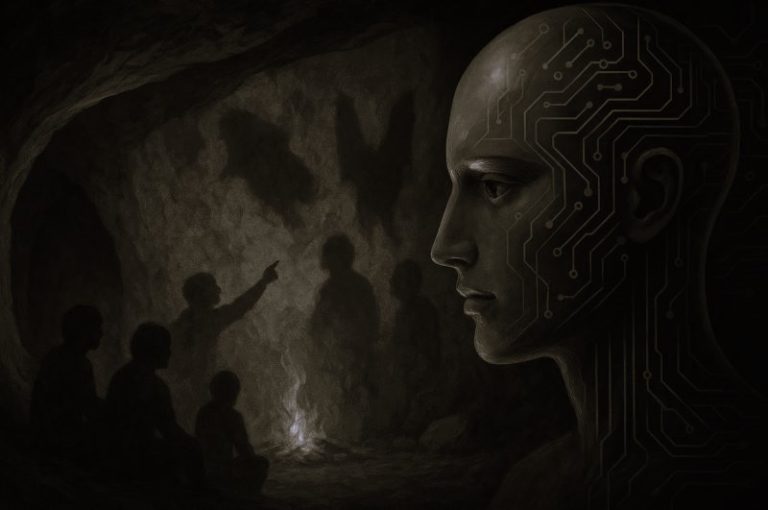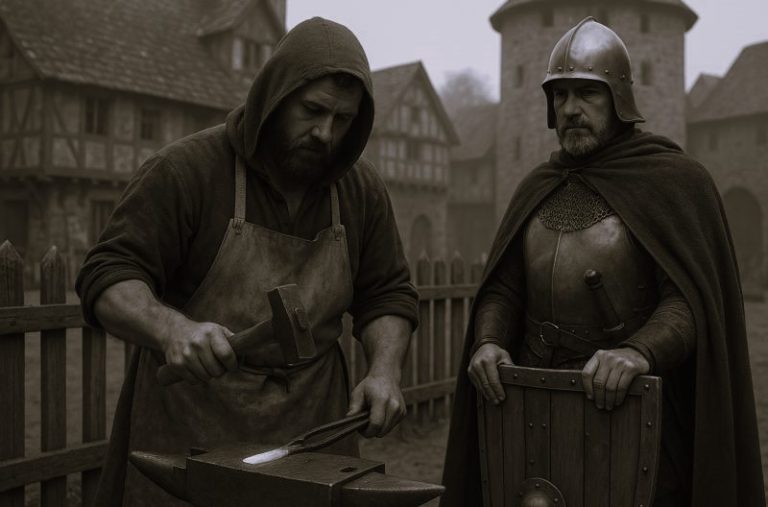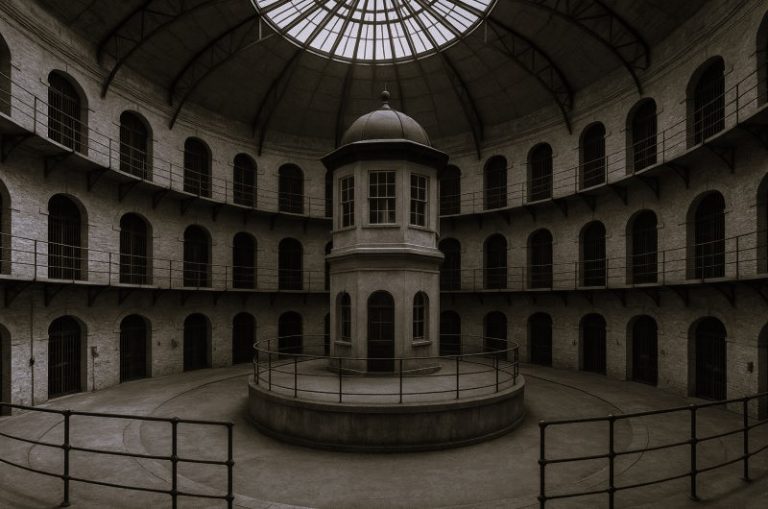

Curated/Reviewed by Matthew A. McIntosh
Public Historian
Brewminate
Introduction
The Ancient Greeks divided themselves into three tribes; the Aeolians, Ionians, and Dorians. The Mycenaeans (referred to as Argives, Achaeans, and Danaans by Homer in the Iliad) were Aeolians and Ionians. Sometime around 1100 BCE, the Dorians, who lived north of the other two tribes, began to raid the Mycenaeans.
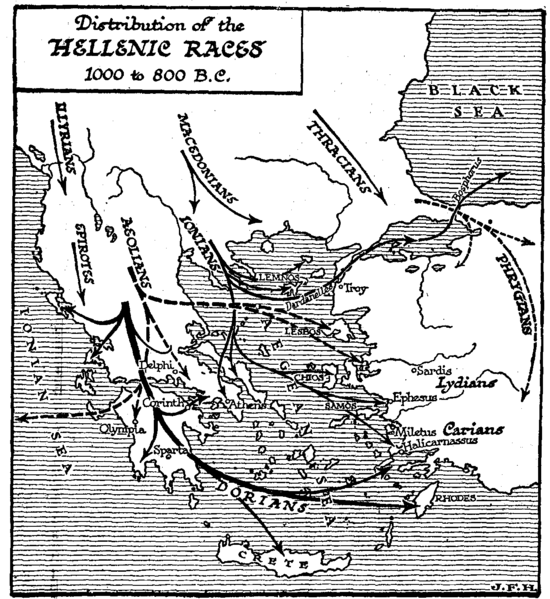
Entire cities were destroyed, and Mycenae itself fell and was plundered by the invaders. Not only were the citadels of Mycenaean Greece destroyed, but civilization itself would collapse in the region.
Economic Impacts
Many theories exist about the cause of the Mycenaeans’ collapse. Ecological disasters may have undermined the economy of the agrarian-based Mycenaeans, allowing the Dorians to supplant their society. The Dorians quickly developed trade relations throughout the Mediterranean to replace the old economy.
The region of Attica (which included Athens) would rise to dominate the region due to its prominence as a trade center. The change was not immediate, however, as Athens, like the rest of Greece, would need a long recovery from the Mycenaean collapse. These new contacts with outside civilizations would have drastic consequences for the future of Greece.
Linguistic Impacts
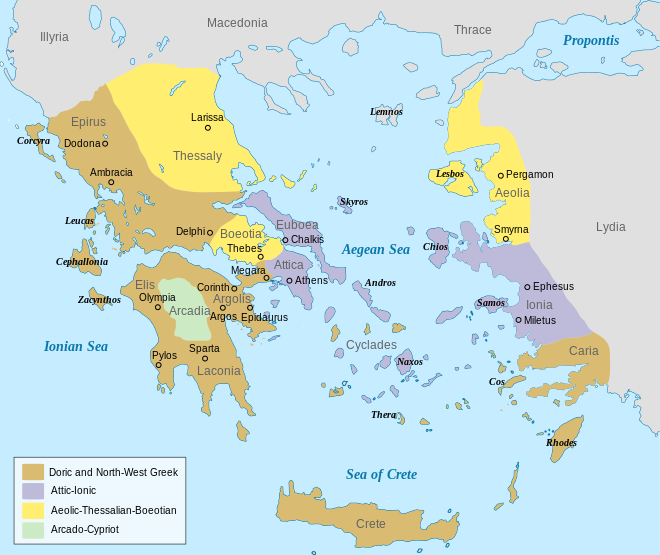
The most significant immediate change for Greece during this time period was the end of writing. No written records exist for this time period, and writings from subsequent time periods are completely different from those of the Mycenaeans, leading historians to believe that writing was completely forgotten during the Dark Ages. The Dorians spoke a dialect different from that of the Mycenaeans, and due to the absence of a writing system, very few records remain of their language. All modern Greek dialects are descended from Attic Greek (“Classical” Greek), with one exception: the endangered Tsakonian dialect, which is a descendant of Doric, and therefore of considerable interest to linguists.
The Dorians would undoubtedly come into contact with the Phoenicians, a powerful seafaring people from the nearby Levant. The Greeks adopted the Phoenecian concept of an alphabet, and through trade would spread this throughout the Mediterranean. This alphabet was the first to include vowels, replacing the syllabic script of Mycenaean Linear B. The word alphabet itself comes from the names of the first two letters of this new writing system: Alpha (Αα) and Beta (Ββ).
Due to the lack of a writing system, poets (also known as bards) would have recited the long stories orally and passed them down over the years. Homer’s epics could very well be versions of stories first composed, but not written, during the Dark Ages.
Weaponry

The Dorians were a warlike people, and thrust Greece into the Iron Age. Weapons were no longer made of bronze but instead, iron. Weapons became cheaper to make, more durable, and more effective in combat. This functionality replaced the ornate beauty of the craftsmanship of the old Mycenaean weapons. The hoplite was the name of the Ancient Greek infantryman who fought in phalanxes. Cavalry was the preserve of the Greek aristocracy due to the status attached to horse ownership. The cuirass, greaves and crested helmet not only offered protection but also presented a formidable display of height and strength to the enemy.
Political Impacts
During the Dark Ages, the polis (plural poleis), or city-state, would begin to develop. Cities dominated the surrounding landscape, and became independent units. The Dorians did not “conquer” the area in the sense of adding the territory to their domain, as the mountains of the region prevented the continuous contact necessary for a single nation to exist. Each city-state was naturally defended by the surrounding mountains, and each constantly expanded at the expense of its neighbors.
Soon after the invasions, monarchies were established in most, if not all, of the poleis. While the monarch held religious as well as political authority, he did not, however, wield complete control of his government. Many city states came to be dominated by the aristocracy. Tyrants first appeared during this time period. A tyrant was an aristocrat who gained enough power and influence to control the polis. They were backed by a personal hoplite army independent of the city-state, and set up autocratic (though not necessarily “tyrannical”, in the modern sense) governments.
Hellenic Identity

Despite the mountains separating Greece from unification, the independent poleis did develop commonalities in culture, language, religion, and government. It was during this time period that Greeks began to identify themselves and each other as Hellenes. In spite of the rivalries among the poleis, they shared the same language, the same style of dress, and the same décor, and these traits served to unite them as one and the same: they were all Hellenes.
Contributing to this sense of loose unity were the Olympic Games, begun in 776 BCE. These featured athletes from the various poleis who competed against one another as a religious ritual. Athletes may have competed for personal glory and fame, but the games were first and foremost in honor of Zeus, king of the gods. Olympia featured a temple which contained a 12-meter high statue of Zeus made of ivory and gold. This massive sculpture, created by the famous Phidias, was one of the Seven Wonders of the Ancient World. These games would cease in 393 CE, when they were banned under Roman Emperor Theodosius I in an effort to stamp out paganism.
Originally published by Wikipedia, 11.02.2005, under a Creative Commons Attribution-ShareAlike 3.0 Unported license.





